Air Filter Buying Guide

Last updated September 7, 2023
High-efficiency air filters are a cost-effective way to help improve indoor air quality, which may be beneficial to family members sensitive to allergens and other particles in the air. Air filters also help keep your furnace’s coils and heat exchangers clean, which may prolong furnace life and keep it running efficiently.
This guide will help you understand The Home Depot’s Air Filter Performance Rating (FPR) system so you can easily choose the best air filters for home use and air filter accessories.
Tip: Replace your HVAC filters four to six times a year for cleaner air and a healthier HVAC system.
Table of Contents
The Home Depot Air Filter Performance Rating System (FPR)
Premium Air Filters: FPR 10
Best Air Filters: FPR 8-9
Better Air Filters: FPR 6-7
Good Air Filters: FPR 4-5
Common Airborne Contaminants
The Home Depot Air Filter Performance Rating System (FPR)
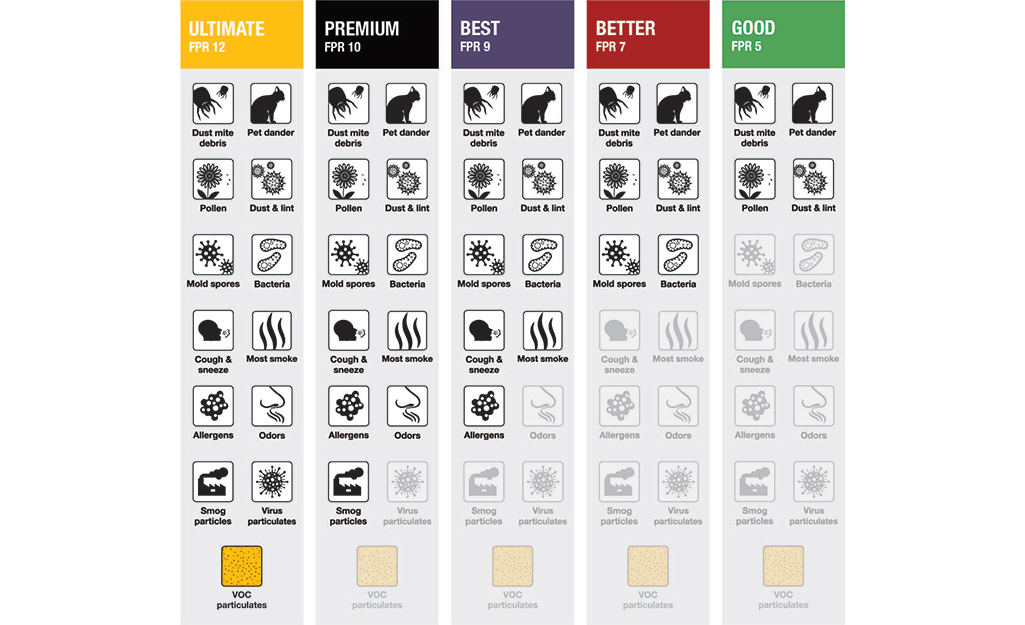
- The Home Depot Air Filter Performance Rating System (FPR) ranks all brands of filters The Home Depot sells by measuring their ability to capture large and small particles. It also factors in the weight gain caused by the filtration process over the filter's lifetime.
- The FPR creates a weighted average for each filter, which is then ranked on a 1 to 12 scale, with 1 being the lowest performance and 12 being the highest performance air filter.
The best air filters for home use are those with the best FPR ratings. - 60 percent of the rating is determined by the filter's ability to capture large particles, 30 percent is determined by its ability to capture small particles and weight gain over the filter's lifetime determines the final 10 percent.
While The Home Depot uses FPR, the industry standard is to use the air filter rating system of Minimum Efficiency Reporting Value (MERV). The MERV rating system helps you choose the best furnace air filters to fit your home’s needs.
Each rating dictates the effectiveness of a filter. The higher the MERV rating, the more efficient the filter. The American Society of Heating, Refrigeration and Air Conditioner Engineers (ASHARE) recommends a MERV 6 or higher. Most people go with a MERV 8 filter. Most residential areas can remove contaminants with MERV 8 to MERV 13, while most hospitals use MERV 14 to MERV 20. Compared to The Home Depot’s method of ranking air filters (FPR), MERV has wider range.
While FPR’s rating system goes from 1 to 12, MERV’s rating system goes from 1 to 20. FPR 10 is similar in strength to MERV 20, since they are both the highest rating value.
However, FPR 1 doesn’t necessarily equate to MERV 1. It isn’t until FPR 4 and 5 that filters start trapping larger particles like household dust and lint, dust mites, pollen and pet dander. Meanwhile, MERV 1 to 4 will trap all these pollutants. Some examples of MERV below:
- MERV 1 to MERV 4: Pollen, dust mites, standing dust, spray paint dust and carpet fibers.
- MERV 5 to MERV 8: Mold spores, hair spray, dust mites, animal dander and cement dust.
- MERV 9 to MERV 12: Humidifier dust, lead dust, auto emissions and milled flour.
- MERV 13 to MERV 16: Household dust and pollen, pet dander, outdoor pollution, mold spores, microscopic allergens, bacteria, most tobacco smoke, sneeze bacteria and virus carriers.
Premium Air Filters: FPR 10
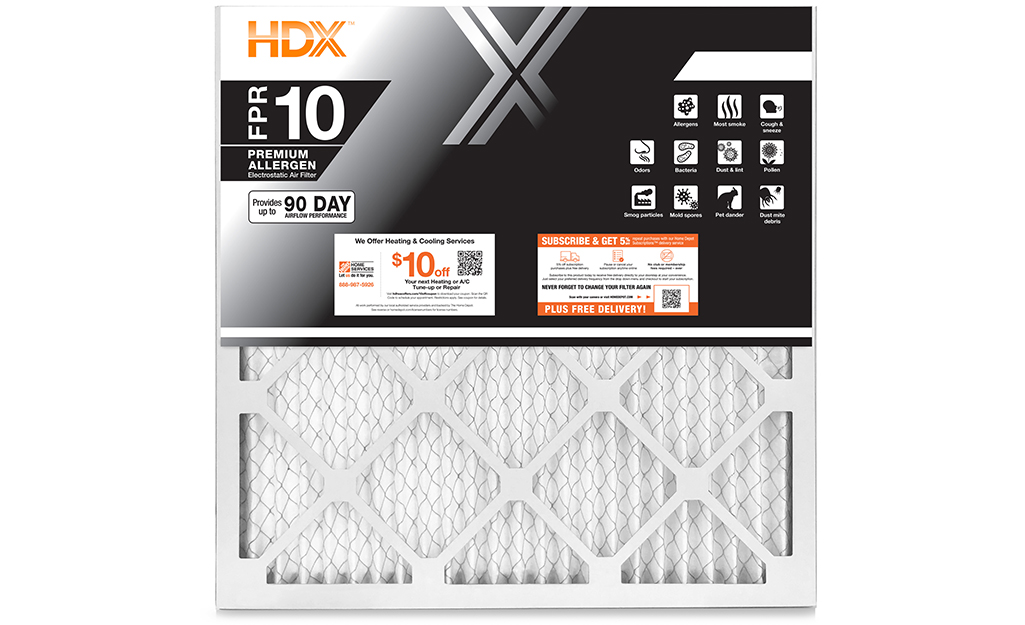
Premium Air Filters: FPR 10 filter out:
- Particles like household dust, lint, dust mites, pollen and pet dander
- Small particles like bacteria and mold spores
- Smoke, smog, microscopic allergens plus particles that can carry viruses
- Particles that carry odors
Best Air Filters: FPR 8-9
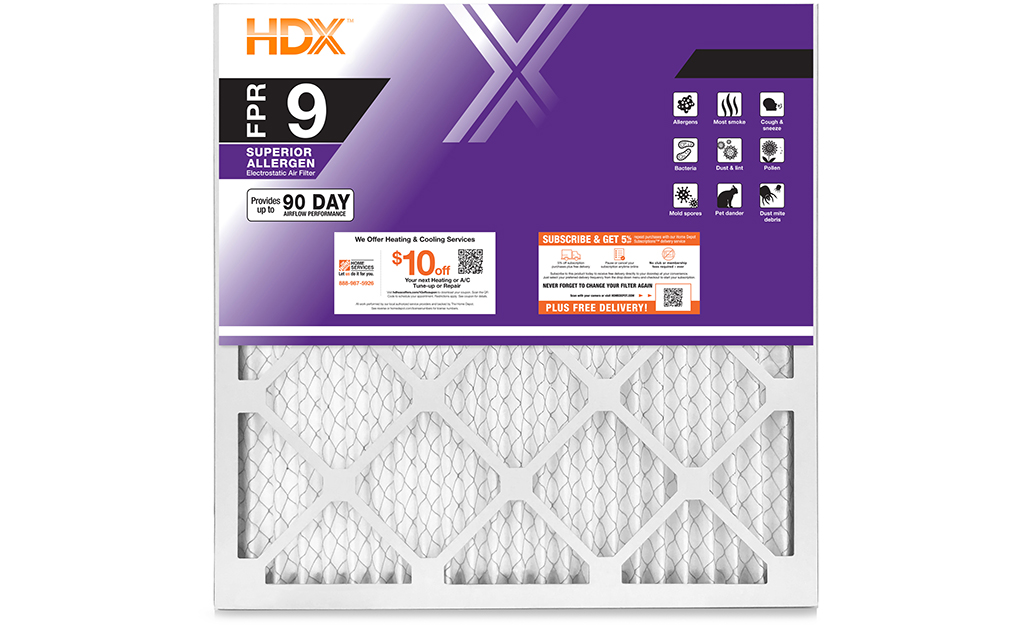
Best Air Filters: FPR 8-9 filter out:
- Large particles like household dust, lint, dust mites, pollen and pet dander
- Small particles like bacteria and mold spores
- Smoke, smog, microscopic allergens plus particles that can carry viruses
Better Air Filters: FPR 6-7
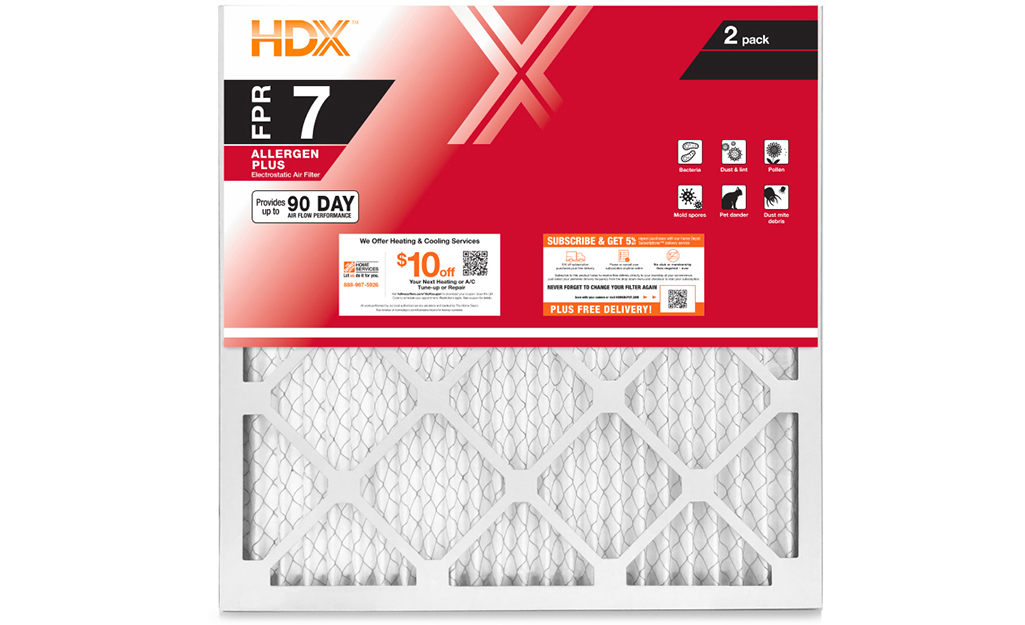
Better Air Filters: FPR 6-7 filter out:
- Large particles like household dust, lint, dust mites, pollen and pet dander
- Small particles like bacteria and mold spores
Good Air Filters: FPR 4-5
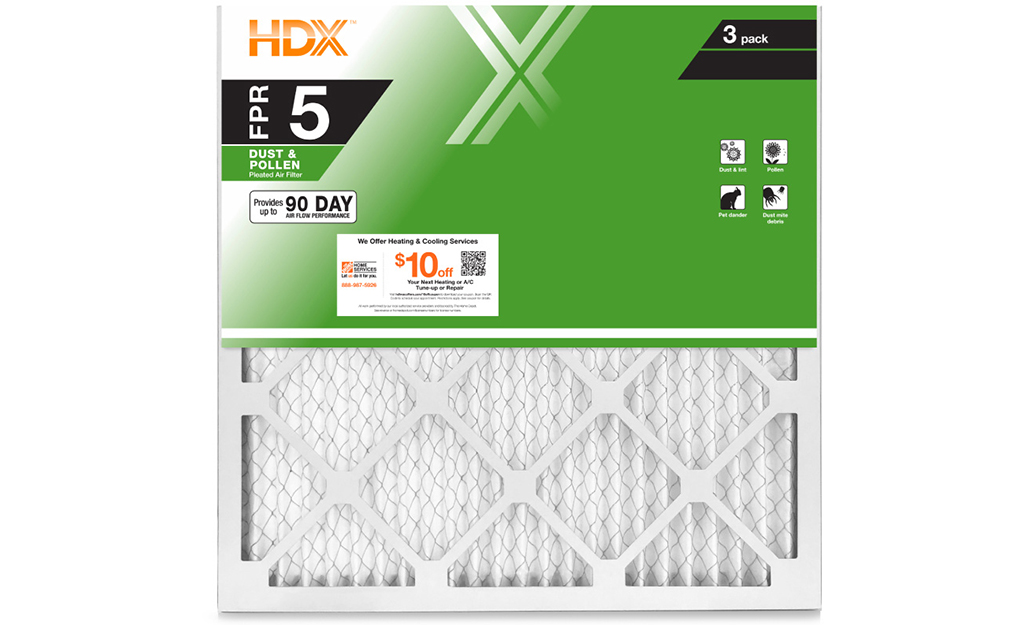
GoodAir Filters: FPR 4-5 filter out:
- Large particles like household dust, lint, dust mites, pollen and pet dander
Common Airborne Contaminants
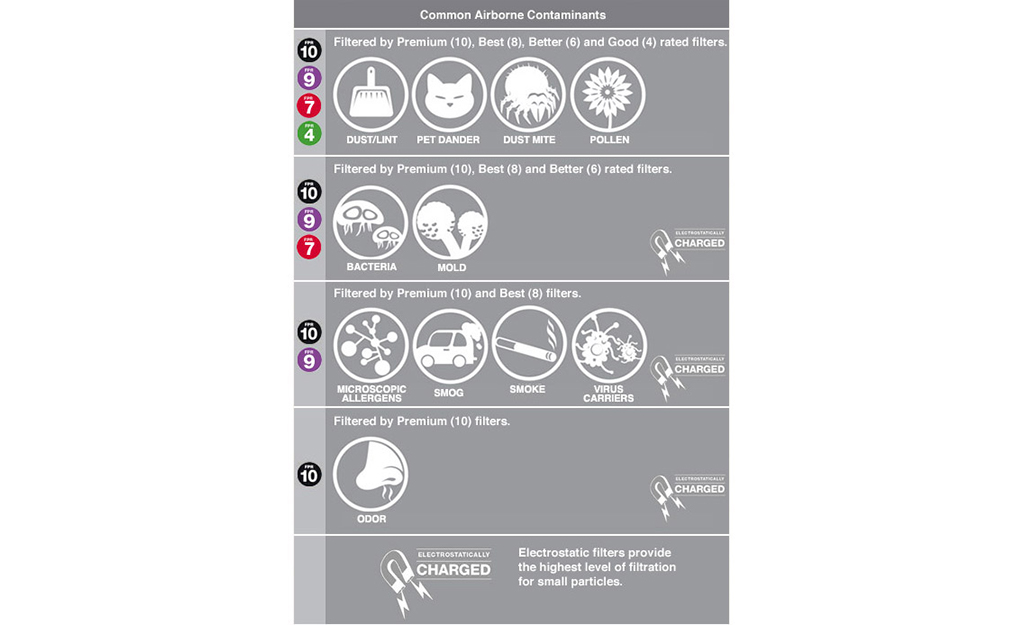
In addition to the filter's strength, the FPR also indicates which type of airborne contaminants each filter is ideally suited to capture.
Contaminants captured by FPR 10, 9, 7, 4 ratings:
- Dust/Lint
- Pet dander
- Dust mite
- Pollen
Contaminants captured by FPR 10, 9, 7 ratings:
- Bacteria
- Mold
Contaminants captured by FPR 10, 9 ratings:
- Microscopic allergens
- Smog
- Smoke
- Virus carriers
Contaminants captured by FPR 10 ratings:
- Odor
Contaminants captured by FPR 12 ratings:
- VOC particulates
Tip: Electrostatically charged air filters provide best filtration of most contaminants.
Air Filter Types
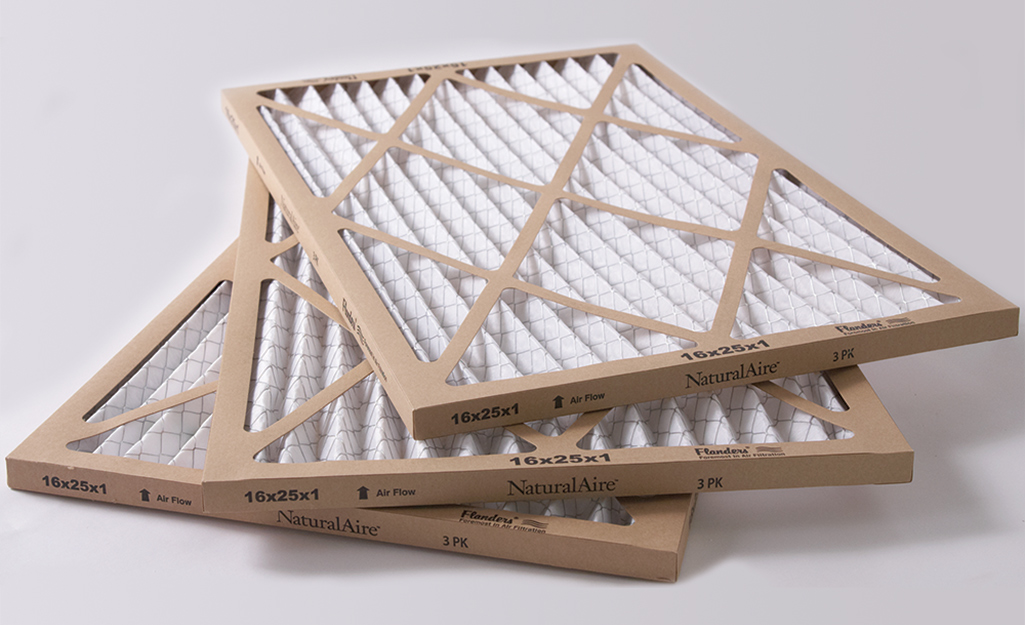
Fiberglass, polyester, washable, pleated and electrostatic filters each offer different air filtering capabilities. Electrostatic filters provide the highest level of filtration for small particles.
Filter Type: Polyester or Fiberglass Air Filters
- Inexpensive
- Disposable
- Good for capturing large particles like lint and dust
Filter Type: Washable Air Filters
- Can be cleaned and reused
- Require replacement only every few years
- Protect furnace motor and trap larger particle
Filter Type: Pleated Air Filters
- Disposable
- Larger surface area captures more particles
Filter Type: Electrostatic Air Filters
- Disposable or reusable options available
- Charged fibers help to capture small and large particles
- Larger surface area captures more particles
Tip: While most filters are disposable, some may be cleaned with water or by vacuum. One advantage of using disposable filters is that you’re not exposed to trapped contaminants during cleaning.
Air Filter Sizes
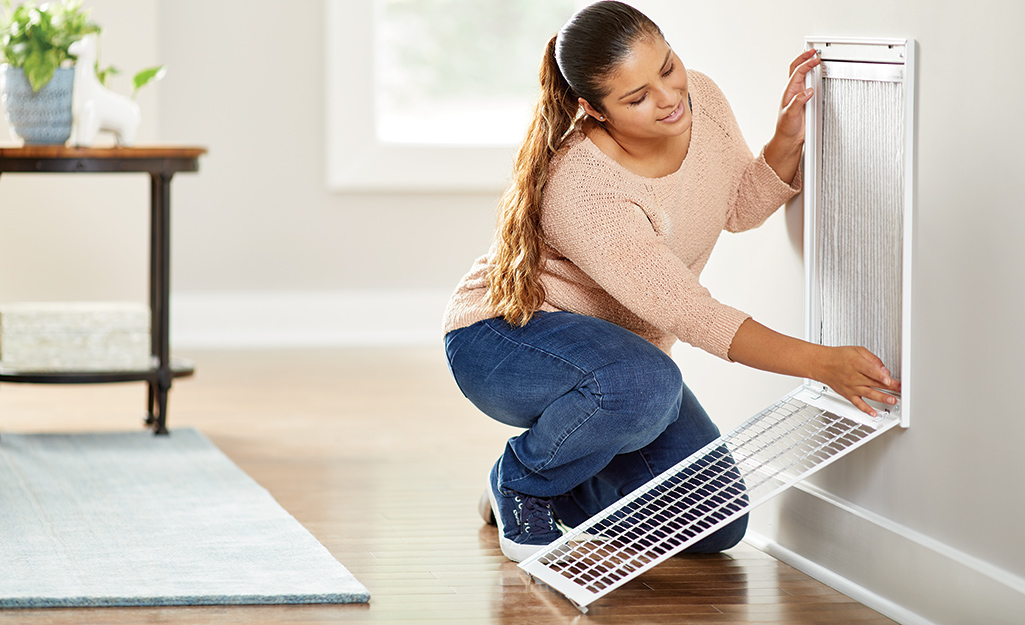
Filters are sized in two ways: nominal and actual. Nominal is the approximate size of the filter, rounded up to the nearest inch. Actual is the filter’s exact size.
In addition to standard height and width dimensions, air filters also vary by thickness. They can be less than one inch thick or up to six inches thick. Not every HVAC system can accommodate thicker filters, as the most common sizes are 1-inch thick. However, a major advantage of a thicker air filter with its bigger pleats is that they don't have to be replaced as often.
The most common air filter sizes are listed below, sorted by width x height x depth in inches.
Getting an exact fit is crucial to having an effective air filter - the wrong size won't fit and will cause the filter to stop working properly. To ensure you get the right fit, take your current air filter out and check the size printed on the frame. And if you need a custom size air filter, The Home Depot has you covered. We also offer subscription eligible air filters for the convenience of automatic delivery.
Even when you understand the best air filters, remembering to change them can be difficult. Set a reminder on your phone each month. Always having the best air filters for home use on hand is easy when you take advantage of our subscription services to get items, such as subscription eligible air filters, conveniently delivered to your home. The Home Depot also offers a full range of air filter accessories, making it easy to keep your system operating at top performance.
If you need help identifying a tool or material, find products fast with image search
in The Home Depot Mobile App. Snap a picture of an item you like and we'll show you similar products.






























